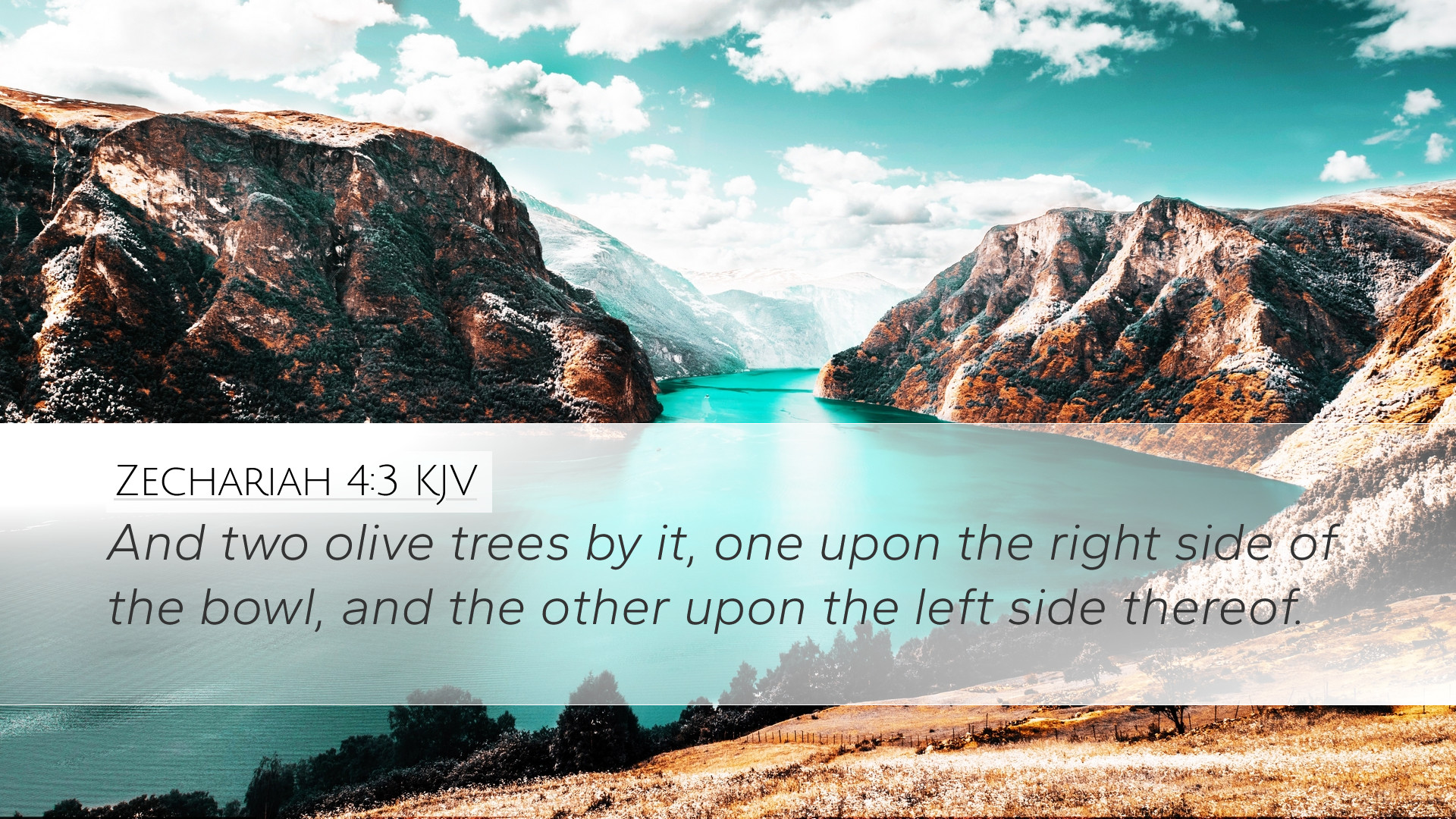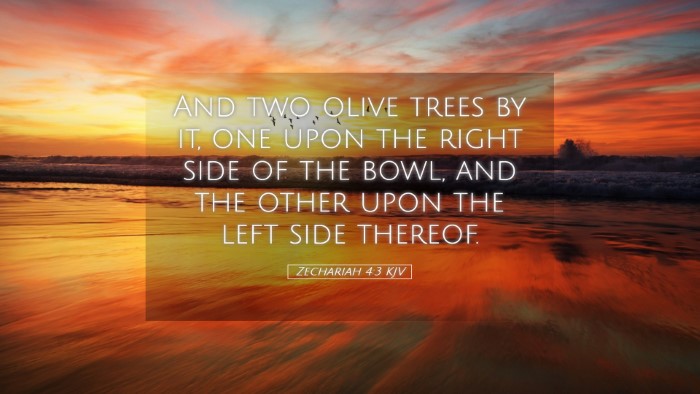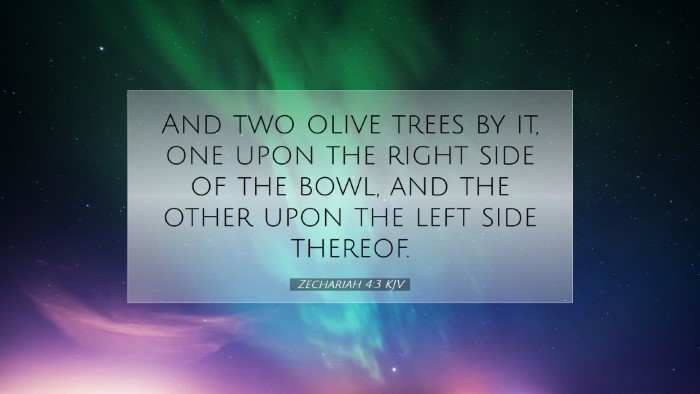Old Testament
Genesis Exodus Leviticus Numbers Deuteronomy Joshua Judges Ruth 1 Samuel 2 Samuel 1 Kings 2 Kings 1 Chronicles 2 Chronicles Ezra Nehemiah Esther Job Psalms Proverbs Ecclesiastes Song of Solomon Isaiah Jeremiah Lamentations Ezekiel Daniel Hosea Joel Amos Obadiah Jonah Micah Nahum Habakkuk Zephaniah Haggai Zechariah MalachiZechariah 4:3
Zechariah 4:3 KJV
And two olive trees by it, one upon the right side of the bowl, and the other upon the left side thereof.
Zechariah 4:3 Bible Commentary
Commentary on Zechariah 4:3
Verse: Zechariah 4:3 - "And two olive trees by it, one upon the right side of the bowl, and the other upon the left side thereof."
Introduction
The prophetic vision of Zechariah includes rich symbolism, of which the two olive trees are significant. This imagery conveys profound theological truths concerning God's presence and provision in the life of His people, especially as related to the restoration of Israel. The following commentary synthesizes insights from notable public domain commentators including Matthew Henry, Albert Barnes, and Adam Clarke.
Contextual Overview
Zechariah was a prophet during the post-exilic period, addressing a disheartened community returning from Babylonian captivity. His prophecies aim to renew hope and instill spiritual vitality in the projects of rebuilding the temple and revitalizing the city of Jerusalem. Understanding the immediate and broader context is vital for a proper interpretation of the imagery presented in this verse.
Symbolism of the Olive Trees
The two olive trees in Zechariah 4:3 symbolize the dual anointing and the unified ministry of God's appointed leaders, particularly Zerubbabel and Joshua the high priest.
- Spiritual Leaders: Zechariah points out the roles of Zerubbabel as the civil leader and Joshua as the spiritual leader. Together, they represent the cooperation between civil governance and spiritual authority in the restoration of Israel.
- Divine Supply: Olive trees are known for their oil, essential for light (symbolized by the candlestick in the preceding verses). The oil represents the Holy Spirit’s anointing, indicating that their leadership is empowered by divine grace.
Theological Implications
Commentators provide profound insights into the implications of the imagery. The olive trees can be viewed as reflections of God’s abundance and His continual provision for His people.
- God's Sustained Presence: The presence of the olive trees signifies that God sustains His people through His Spirit. Matthew Henry notes that the oil is a symbol of grace, flowing continually from the trees to the lamps, which represents the church's illumination and guidance.
- The Anointed Ones: Albert Barnes elaborates the idea of 'the two anointed ones' as representative of those who are chosen and empowered by God for service. This indicates that anointing is not just a ceremonial act but a divine enablement for fulfilling God’s tasks.
- Unity in Purpose: Adam Clarke emphasizes the duality yet unity of the olive trees, suggesting that while Zerubbabel and Joshua served different roles, they were unified in their purpose to restore and establish God's people.
Historical and Cultural Context
An understanding of the historical and cultural context is essential. The olive tree is a significant symbol in the Middle Eastern cultures, representing peace, prosperity, and divine blessing. The people of Israel, familiar with this symbolism, would recognize the olive trees as a sign of hope for restoration following their exile.
- Restoration Themes: The agricultural imagery of the olive trees likely resonates with the agrarian context of ancient Israel, symbolizing the restoration of God's blessings in terms of land, resources, and spiritual renewal.
- Connection with Messianic Expectations: Some interpretations connect the olive trees to messianic figures, foreshadowing the ultimate restoration and kingship in Christ, who fulfills the roles of king and priest.
Application for Today
Understanding Zechariah 4:3 transcends its historical context and invites modern readers to reflect on their spiritual leadership, community reliance on God, and the continual reception of His grace through the Holy Spirit.
- Empowerment for Service: Pastors and leaders can glean from this passage the importance of relying on the Holy Spirit in their ministry. As they fulfill their calling, they should remember that God provides the necessary oil for their lamps to shine brightly in the world.
- Unity Among Leaders: The collaboration between spiritual and civil authorities was essential in Zechariah's time, and it remains vital today. The Church is called to work harmoniously with civic leaders to promote justice and righteousness.
- Continual Restoration: Just as God assured the Israelites of His restoration, believers can be encouraged that God's hands are at work even in challenging circumstances, leading to spiritual renewal and revitalization in contemporary contexts.
Conclusion
Zechariah 4:3, with its vivid imagery of two olive trees, is not merely an ancient symbol but a profound communication from God about His ongoing commitment to His people. The insights gleaned from the commentaries highlight divine provision, the necessity of spiritual leadership, and the unyielding hope for restoration. These themes resonate deeply within the contemporary church and offer guidance for understanding God's work in the world today.


